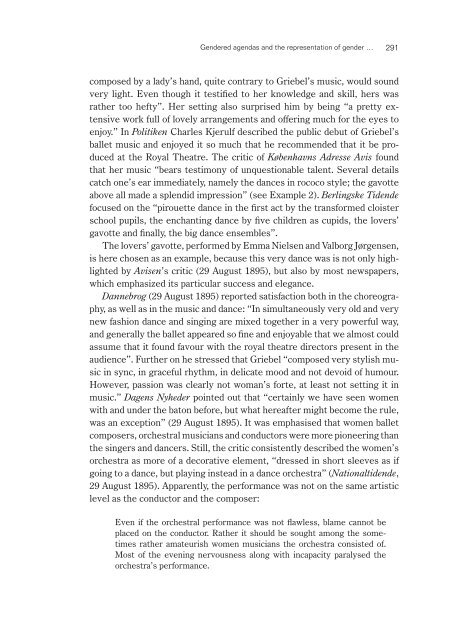Opera on the Move in the Nordic Countries during the Long 19th ...
Opera on the Move in the Nordic Countries during the Long 19th ...
Opera on the Move in the Nordic Countries during the Long 19th ...
You also want an ePaper? Increase the reach of your titles
YUMPU automatically turns print PDFs into web optimized ePapers that Google loves.
Gendered agendas and <strong>the</strong> representati<strong>on</strong> of gender …<br />
291<br />
composed by a lady’s hand, quite c<strong>on</strong>trary to Griebel’s music, would sound<br />
very light. Even though it testified to her knowledge and skill, hers was<br />
ra<strong>the</strong>r too hefty”. Her sett<strong>in</strong>g also surprised him by be<strong>in</strong>g “a pretty extensive<br />
work full of lovely arrangements and offer<strong>in</strong>g much for <strong>the</strong> eyes to<br />
enjoy.” In Politiken Charles Kjerulf described <strong>the</strong> public debut of Griebel’s<br />
ballet music and enjoyed it so much that he recommended that it be produced<br />
at <strong>the</strong> Royal Theatre. The critic of Københavns Adresse Avis found<br />
that her music “bears testim<strong>on</strong>y of unquesti<strong>on</strong>able talent. Several details<br />
catch <strong>on</strong>e’s ear immediately, namely <strong>the</strong> dances <strong>in</strong> rococo style; <strong>the</strong> gavotte<br />
above all made a splendid impressi<strong>on</strong>” (see Example 2). Berl<strong>in</strong>gske Tidende<br />
focused <strong>on</strong> <strong>the</strong> “pirouette dance <strong>in</strong> <strong>the</strong> first act by <strong>the</strong> transformed cloister<br />
school pupils, <strong>the</strong> enchant<strong>in</strong>g dance by five children as cupids, <strong>the</strong> lovers’<br />
gavotte and f<strong>in</strong>ally, <strong>the</strong> big dance ensembles”.<br />
The lovers’ gavotte, performed by Emma Nielsen and Valborg Jørgensen,<br />
is here chosen as an example, because this very dance was is not <strong>on</strong>ly highlighted<br />
by Avisen’s critic (29 August 1895), but also by most newspapers,<br />
which emphasized its particular success and elegance.<br />
Dannebrog (29 August 1895) reported satisfacti<strong>on</strong> both <strong>in</strong> <strong>the</strong> choreography,<br />
as well as <strong>in</strong> <strong>the</strong> music and dance: “In simultaneously very old and very<br />
new fashi<strong>on</strong> dance and s<strong>in</strong>g<strong>in</strong>g are mixed toge<strong>the</strong>r <strong>in</strong> a very powerful way,<br />
and generally <strong>the</strong> ballet appeared so f<strong>in</strong>e and enjoyable that we almost could<br />
assume that it found favour with <strong>the</strong> royal <strong>the</strong>atre directors present <strong>in</strong> <strong>the</strong><br />
audience”. Fur<strong>the</strong>r <strong>on</strong> he stressed that Griebel “composed very stylish music<br />
<strong>in</strong> sync, <strong>in</strong> graceful rhythm, <strong>in</strong> delicate mood and not devoid of humour.<br />
However, passi<strong>on</strong> was clearly not woman’s forte, at least not sett<strong>in</strong>g it <strong>in</strong><br />
music.” Dagens Nyheder po<strong>in</strong>ted out that “certa<strong>in</strong>ly we have seen women<br />
with and under <strong>the</strong> bat<strong>on</strong> before, but what hereafter might become <strong>the</strong> rule,<br />
was an excepti<strong>on</strong>” (29 August 1895). It was emphasised that women ballet<br />
composers, orchestral musicians and c<strong>on</strong>ductors were more pi<strong>on</strong>eer<strong>in</strong>g than<br />
<strong>the</strong> s<strong>in</strong>gers and dancers. Still, <strong>the</strong> critic c<strong>on</strong>sistently described <strong>the</strong> women’s<br />
orchestra as more of a decorative element, “dressed <strong>in</strong> short sleeves as if<br />
go<strong>in</strong>g to a dance, but play<strong>in</strong>g <strong>in</strong>stead <strong>in</strong> a dance orchestra” (Nati<strong>on</strong>altidende,<br />
29 August 1895). Apparently, <strong>the</strong> performance was not <strong>on</strong> <strong>the</strong> same artistic<br />
level as <strong>the</strong> c<strong>on</strong>ductor and <strong>the</strong> composer:<br />
Even if <strong>the</strong> orchestral performance was not flawless, blame cannot be<br />
placed <strong>on</strong> <strong>the</strong> c<strong>on</strong>ductor. Ra<strong>the</strong>r it should be sought am<strong>on</strong>g <strong>the</strong> sometimes<br />
ra<strong>the</strong>r amateurish women musicians <strong>the</strong> orchestra c<strong>on</strong>sisted of.<br />
Most of <strong>the</strong> even<strong>in</strong>g nervousness al<strong>on</strong>g with <strong>in</strong>capacity paralysed <strong>the</strong><br />
orchestra’s performance.
















